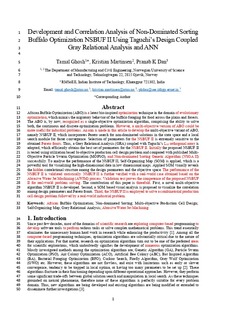| dc.description.abstract | African Buffalo Optimization (ABO) is a latest bio-inspired optimization technique in the domain of evolutionary optimization, which mimics the migratory behavior of the buffalo foraging for food across the plains and forests. The ABO is, by now, recognized as a single-objective optimization algorithm, comprising the ability to solve both, the continuous and discrete optimization problems. However, a multi-objective version of ABO could be more useful for industrial problems. An aim is made in this article to develop the multi-objective variant of ABO, namely NSBUF II, which incorporates Pareto search for non-dominated solutions in the state space and a local search module for faster convergence. Selection of parameters for the NSBUF II is extremely sensitive to the obtained Pareto fronts. Thus, a Grey Relational Analysis (GRA) coupled with Taguchi’s L16 orthogonal array is adopted, which efficiently obtains the best set of parameters for the NSBUF II. Initially the proposed NSBUF II is tested using utilization based bi-objective production cell design problem and compared with published Multi-Objective Particle Swarm Optimization (MOPSO), and Non-dominated Sorting Genetic Algorithm (NSGA II) successfully. To analyse the performance of the NSBUF II, Self-Organizing Map (SOM) is applied, which is a powerful tool for visualizing the high-dimensional data in low dimensional maps. Applied SOM visually reveals the hidden correlational structure among the design parameters and the objective space. The performance of the NSBUF II is validated statistically NSBUF II is further verified with a real-world case obtained based on the Abrasive Water Jet Machining (AWJM) process. Validation test proves the competence of the proposed NSBUF II for real-world problem solving. The contribution of this paper is threefold. First, a novel multi-objective algorithm NSBUF II is developed. Second, a SOM based visual analysis is proposed to visualize the correlation among design parameters and Pareto fronts. Third, the NSBUF II is employed to solve a combinatorial production cell design problem followed by a real-world industrial problem. | nb_NO |

